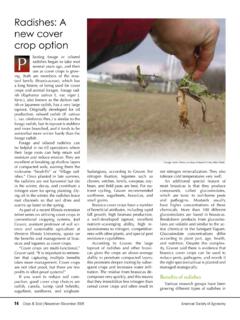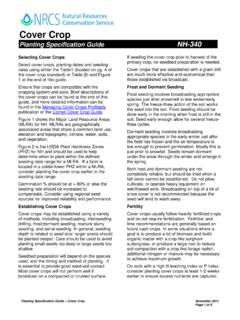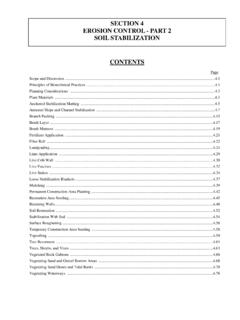Transcription of Testing Your Soil Why and How to Take a Soil-Test ... - USDA
1 Organic carbon (C) analysis, like N analysis, is use-ful only in special circumstances. Most soils benefitfrom additions of organic matter. Aluminum (Al) in soils can be toxic to plants if pHis low and the Al is too available to them. Knowingthe soil s pH and classification is the first step in pre-dicting Al problems, and tests for extractable Alcan then be done if necessary. Micronutrient levels in the soil may be analyzedwhen crop symptoms suggest problems. Micronutri-ents often measured include boron (B), copper (Cu),manganese (Mn), and zinc (Zn).These specialized soil tests usually are not called forunless crop growth problems have been observed or thereare other reasons to suspect that they are a good soil sampleSoil tests are done on a sample that is only a tinyfraction of a field or garden plot.
2 Soil treatment recom-mendations assume that data from the analysis of thattiny fraction represent the entire area to be treated. There-fore, care must be taken to ensure that the soil sampletruly represents the field or differences can be seen in the soil from variousparts of the overall area to be sampled, each distinct sub-area should be sampled separately. Differences in soilcolor or texture are obvious reasons for taking separatesamples. Other reasons include differences in land slope,soil drainage, crop management history (different soilamendments or fertilizers ), variations currently observedin crop growth, or variations in the natural soil sample analyzed should be a combinationof 5 to 10 subsamples taken from the soil area of inter-est.
3 The subsamples should each be about the sameWhy have a soil tested?Does my soil have problems?Does my crop need fertilizer?What kind of fertilizer should I use?How much should I apply?A soil analysis can help farmers and gardeners answerthese questions. A basic soil analysis provides informa-tion on two important soil characteristics: Soil pH is a measurement on a scale from acid (lowpH) to alkaline (high pH). Most soils are on the acidside of the pH spectrum. Good soils for crop produc-tion are often moderately acid, but some soils in Ha-waii are acidic to the extent that crops grow tests indicate pH problems and allow recommen-dations for correcting them.
4 Available nutrient levels in the soil determine howgood crop growth will be. Testing for phosphorus (P),potassium (K), calcium (Ca), and magnesium (Mg)helps determine the need for soil amendments (phos-phate, and lime or dolomite) and the right fertilizerformulations for the crop to be addition to the basic information on pH and levels ofmajor nutrients, specialized soil analyses can help toinvestigate other factors that may limit crop growth: Soil salinity can build up in coastal areas and in soilsirrigated with brackish water or to which too muchfertilizer has been applied. nitrogen (N) is required in large quantities by mostcrops, and adding N is a basic part of most fertilizerprograms.
5 In special circumstances, N can be ana-lyzed as total N, ammoniacal N (NH4-N), or nitrateN (NO3-N), but this is not usually done because Ndoes not remain in the root zone for very Extension ServiceAgronomy and SoilsNov. 1997 AS-4 Testing Your SoilWhy and How to Take a Soil-Test SamplePublished by the College of Tropical Agriculture and Human Resources (CTAHR), University of Hawaii, and issued in furtherance of Cooperative Extension work,Acts of May 8 and June 30, 1914, in cooperation with the Department of Agriculture. Charles W. Laughlin, Director and Dean, Cooperative Extension Service,CTAHR, Honolulu, Hawaii 96822.
6 The University is an equal opportunity / affirmative action institution providing programs and services to the people of Hawaiiwithout regard to race, sex, age, religion, color, national origin, ancestry, disability, marital status, arrest and court record, sexual orientation, or veteran of soil, and they should be mixed together thor-oughly as they are collected. The final sample taken fromthis mixture is called a composite large an area to sample? For home gardens,one sample that is representative of the garden plot isusually sufficient. For orchards or farms, even if no dis-tinctly different soil types are noticeable, large areasshould be subdivided into sample areas of 2 5 acres andsampled equipment do I need?
7 Map the area sampled if you are taking more thanone sample. Mark each sampled area on the map witha label that you will also write on the sample bag. spade or shovel (for specialized soil tests, tools shouldpreferably be made of steel, because tools made ofbrass, bronze, or galvanized metal may contaminatesamples with copper or zinc) plastic bucket or large plastic bag for collecting andmixing subsamples plastic bag to contain about 2 cups (1 pint) of thefinal, composite soil sample (thin plastic bags thatcan breathe, such as sandwich bags, are better thanthick plastic bags for storing soil; brown paper bagscan contaminate samples to be tested for boron) waterproof marker to label the plastic bag to iden-tify the sampleCollecting the soil sampleFor each distinct soil area you are sampling, take 5to 10 subsamples and mix them together to obtain thefinal sample.
8 Take the subsamples by selecting spots ina pattern that ensures a balanced representation of thewhole area sampled. Don t sample spots that look atypi-cal of the area being clean tools to sample soil, a clean container tomix it, and clean bags to store it. Small amounts of con-taminants, especially fertilizer or lime, can distort theanalysis deep to sample? the top 4 inches for lawns, turf, established pasture,and no-till fields the top 8 inches for conventionally tilled fields andgarden plots the top 8 inches plus a separate sample for the 8 24inch zone for tree cropsThe sampling surface litter and plant growth from the samplespot.
9 Dig a hole about as wide as your spade and asdeep as the layer you are the spade tip placed one inch outside the edgeof the hole, cut down to remove a slice of one side ofthe hole that slice on the blade of the spade, use atrowel, knife, or stick to cut away the sides of theslice, leaving a center section about 1 inch wide. This1 x 1 inch vertical section of the soil is the subsamples in the plastic container, mixthem together well, and remove about 2 cups (1 pint)of this mixture. This is your composite sample, tosend to the laboratory for the sample analyzedThe Agricultural Diagnostic Service Center (ADSC)of the College of Tropical Agriculture and Human Re-sources (CTAHR) at the University of Hawaii at Manoaprovides residents of Hawaii with a reasonably pricedsoil and plant-tissue Testing service.
10 Samples for analy-sis by ADSC can be taken to county offices of theCTAHR Cooperative Extension Service (CES), or theycan be mailed directly to ADSC at 1910 East-WestRoad Room 134, Honolulu, HI samples sent to ADSC should be accompaniedby the ADSC soil information form (p. 4). Completeinformation helps ADSC provide more accurate recom-AS-4 Testing Your SoilCTAHR Nov. 19972 Collect soil samples in a zig-zag pattern AS-4 Testing Your SoilCTAHR Nov. 1997mendations. Helpful information about your soil sampleincludes: an estimation of the soil texture, either heavy (whichapplies to many of Hawaii s soils), light (soils de-rived from volcanic ash on the Big Island), or a a(irregular pieces of lava) a description of the plot or field (slope, presence ofrocks, drainage problems) the kind of plants presently growing at the site (natu-ral vegetation or crops)













